2023 NISSAN PATHFINDER fold seats
[x] Cancel search: fold seatsPage 15 of 665

1. Seat belt (3rd row outboard seat; driv-er’s side shown; passenger side similar)
(P. 1-20)
2. Folding 3rd row bench (P. 1-9)
3. Seat belt (3rd row center seat) (P. 1-20) 4. Folding 2nd row bench (if so equipped)
(P. 1-6)
5. Seat belt (2nd row center seat
(if so equipped)) (P. 1-20) 6. Roof-mounted curtain side-impact and
rollover supplemental air bag (P. 1-75)
7. Head restraints/headrests (P. 1-13)
8. Seat belts with pretensioner(s) and
shoulder height adjuster (driver’s side
shown; front passenger side similar)
(P. 1-20, 1-79)
9. Supplemental air bags (P. 1-59)
10. Driver supplemental knee air bag
(P. 1-77)
Front passenger supplemental knee air
bag (P. 1-77)
11. Occupant classification sensor (weight
sensor) (P. 1-70)
12. Front central seat-mounted side-
impact supplemental air bag
(if so equipped) (P. 1-75)
13. Seats (P. 1-2)
14. Front seat-mounted side-impact
supplemental air bag (P. 1-75)
15. LATCH (Lower Anchors and Tethers for
CHildren) (P. 1-35)
16. 2nd row seat-mounted side-impact
supplemental air bag (P. 1-75)
17. 2nd row seat top tether strap anchor
(located on bottom of seatback) (P. 1-40)
18. 2nd row outboard seat belts with
pretensioner(s) (P. 1-20, 1-79)
Refer to the page number indicated in
parentheses for operating details.
LII2683
AIR BAGS, SEAT BELTS AND CHILD
RESTRAINTS
0-2Illustrated table of contents
Page 25 of 665
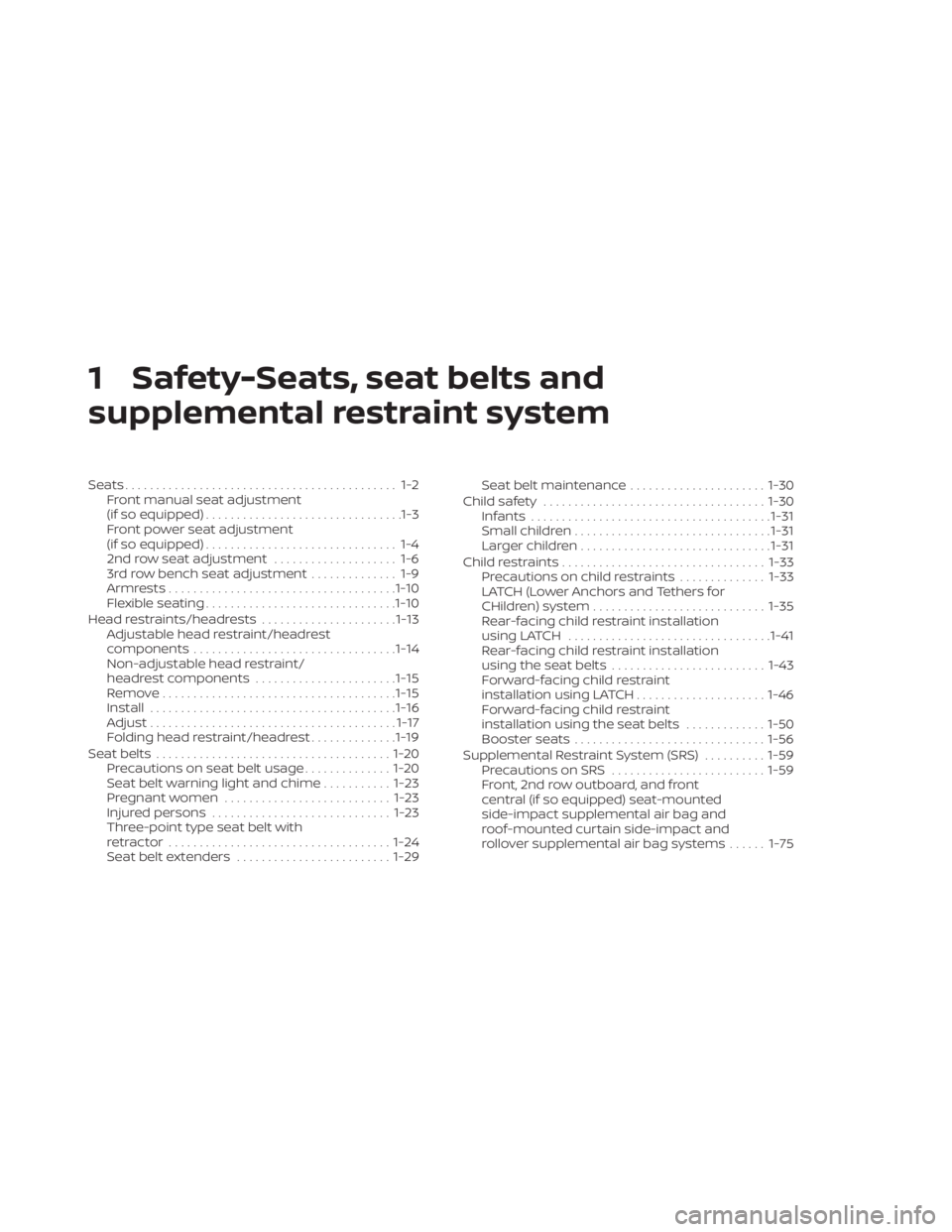
1 Safety-Seats, seat belts and
supplemental restraint system
Seats............................................ 1-2Front manual seat adjustment
(if so equipped) ................................1-3
Front power seat adjustment
(if so equipped) ............................... 1-4
2nd row seat adjustment .................... 1-6
3rd row bench seat adjustment .............. 1-9
Armrests ..................................... 1-10
Flexible seating ............................... 1-10
Head restraints/headrests ......................1-13
Adjustable head restraint/headrest
components ................................. 1-14
Non-adjustable head restraint/
headrest components .......................1-15
Remove...................................... 1-15
Install ........................................ 1-16
Adjust ........................................ 1-17
Folding head restraint/headrest ..............1-19
Seatbelts ...................................... 1-20
Precautions on seat belt usage ..............1-20
Seat belt warning light and chime ...........1-23
Pregnant women ........................... 1-23
Injured persons ............................. 1-23
Three-point type seat belt with
retractor .................................... 1-24
Seat belt extenders ......................... 1-29Seat belt maintenance
......................1-30
Child safety .................................... 1-30
Infants ....................................... 1-31
Small children ................................ 1-31
Larger children ............................... 1-31
Child restraints ................................. 1-33
Precautions on child restraints ..............1-33
LATCH (Lower Anchors and Tethers for
CHildren) system ............................ 1-35
Rear-facing child restraint installation
using LATCH ................................. 1-41
Rear-facing child restraint installation
using the seat belts ......................... 1-43
Forward-facing child restraint
installation using LATCH .....................1-46
Forward-facing child restraint
installation using the seat belts .............1-50
Booster seats ............................... 1-56
Supplemental Restraint System (SRS) ..........1-59
Precautions on SRS ......................... 1-59
Front, 2nd row outboard, and front
central (if so equipped) seat-mounted
side-impact supplemental air bag and
roof-mounted curtain side-impact and
rollover supplemental air bag systems ......
1-75
Page 32 of 665
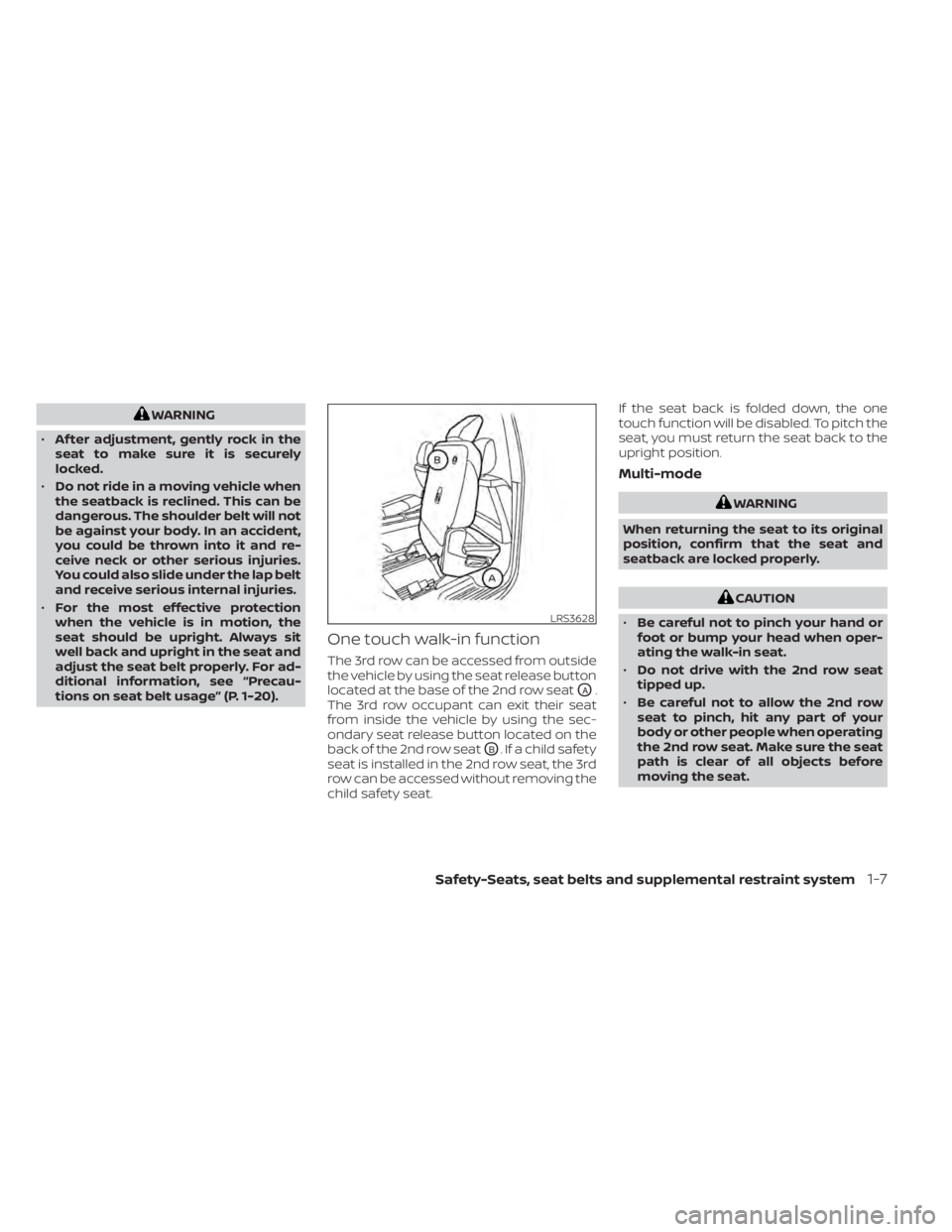
WARNING
• Af ter adjustment, gently rock in the
seat to make sure it is securely
locked.
• Do not ride in a moving vehicle when
the seatback is reclined. This can be
dangerous. The shoulder belt will not
be against your body. In an accident,
you could be thrown into it and re-
ceive neck or other serious injuries.
You could also slide under the lap belt
and receive serious internal injuries.
• For the most effective protection
when the vehicle is in motion, the
seat should be upright. Always sit
well back and upright in the seat and
adjust the seat belt properly. For ad-
ditional information, see “Precau-
tions on seat belt usage” (P. 1-20).
One touch walk-in function
The 3rd row can be accessed from outside
the vehicle by using the seat release button
located at the base of the 2nd row seat
OA.
The 3rd row occupant can exit their seat
from inside the vehicle by using the sec-
ondary seat release button located on the
back of the 2nd row seat
OB. If a child safety
seat is installed in the 2nd row seat, the 3rd
row can be accessed without removing the
child safety seat. If the seat back is folded down, the one
touch function will be disabled. To pitch the
seat, you must return the seat back to the
upright position.
Multi-mode
WARNING
When returning the seat to its original
position, confirm that the seat and
seatback are locked properly.
CAUTION
• Be careful not to pinch your hand or
foot or bump your head when oper-
ating the walk-in seat.
• Do not drive with the 2nd row seat
tipped up.
• Be careful not to allow the 2nd row
seat to pinch, hit any part of your
body or other people when operating
the 2nd row seat. Make sure the seat
path is clear of all objects before
moving the seat.
LRS3628
Safety-Seats, seat belts and supplemental restraint system1-7
Page 35 of 665
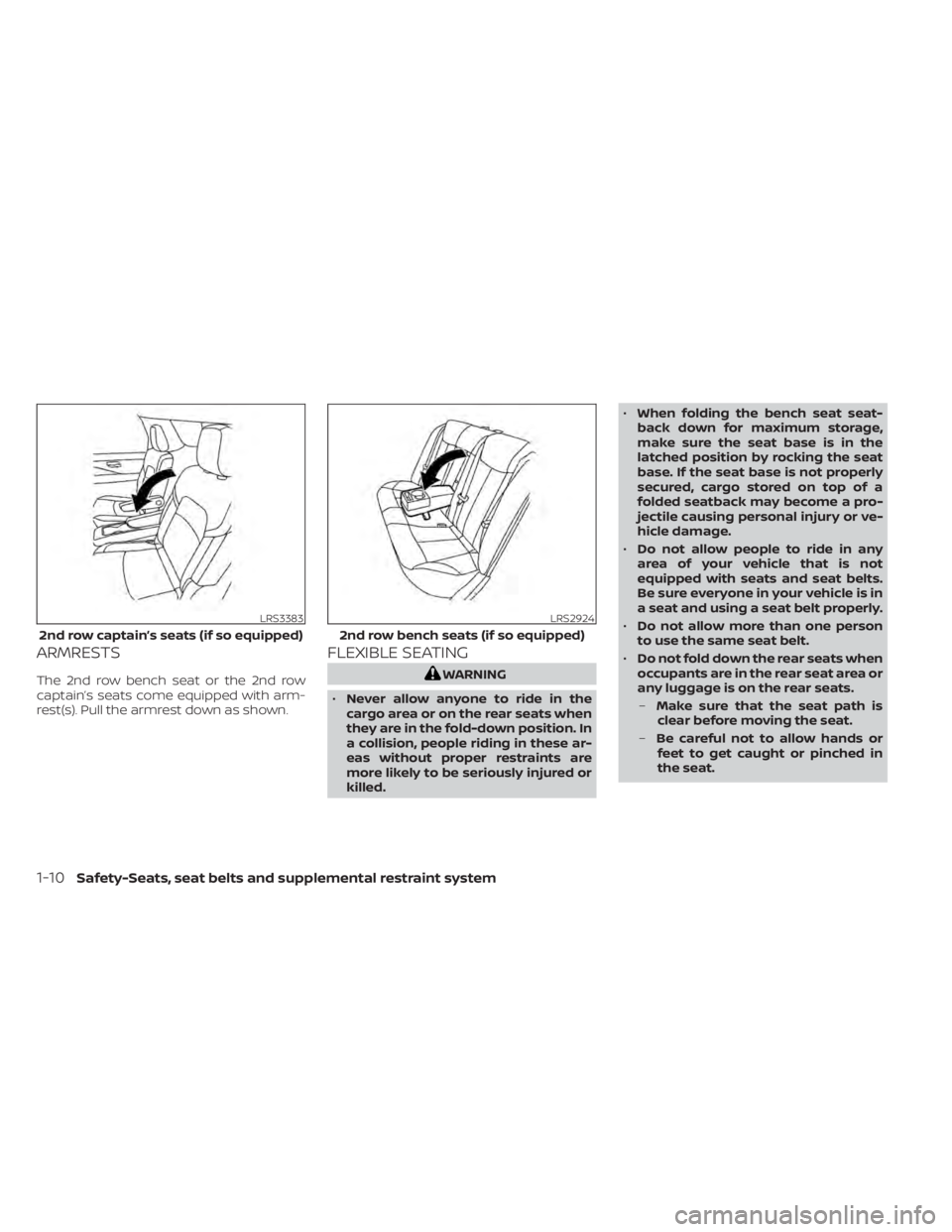
ARMRESTS
The 2nd row bench seat or the 2nd row
captain’s seats come equipped with arm-
rest(s). Pull the armrest down as shown.
FLEXIBLE SEATING
WARNING
• Never allow anyone to ride in the
cargo area or on the rear seats when
they are in the fold-down position. In
a collision, people riding in these ar-
eas without proper restraints are
more likely to be seriously injured or
killed. •
When folding the bench seat seat-
back down for maximum storage,
make sure the seat base is in the
latched position by rocking the seat
base. If the seat base is not properly
secured, cargo stored on top of a
folded seatback may become a pro-
jectile causing personal injury or ve-
hicle damage.
• Do not allow people to ride in any
area of your vehicle that is not
equipped with seats and seat belts.
Be sure everyone in your vehicle is in
a seat and using a seat belt properly.
• Do not allow more than one person
to use the same seat belt.
• Do not fold down the rear seats when
occupants are in the rear seat area or
any luggage is on the rear seats.
– Make sure that the seat path is
clear before moving the seat.
– Be careful not to allow hands or
feet to get caught or pinched in
the seat.
LRS3383
2nd row captain’s seats (if so equipped)
LRS2924
2nd row bench seats (if so equipped)
1-10Safety-Seats, seat belts and supplemental restraint system
Page 36 of 665
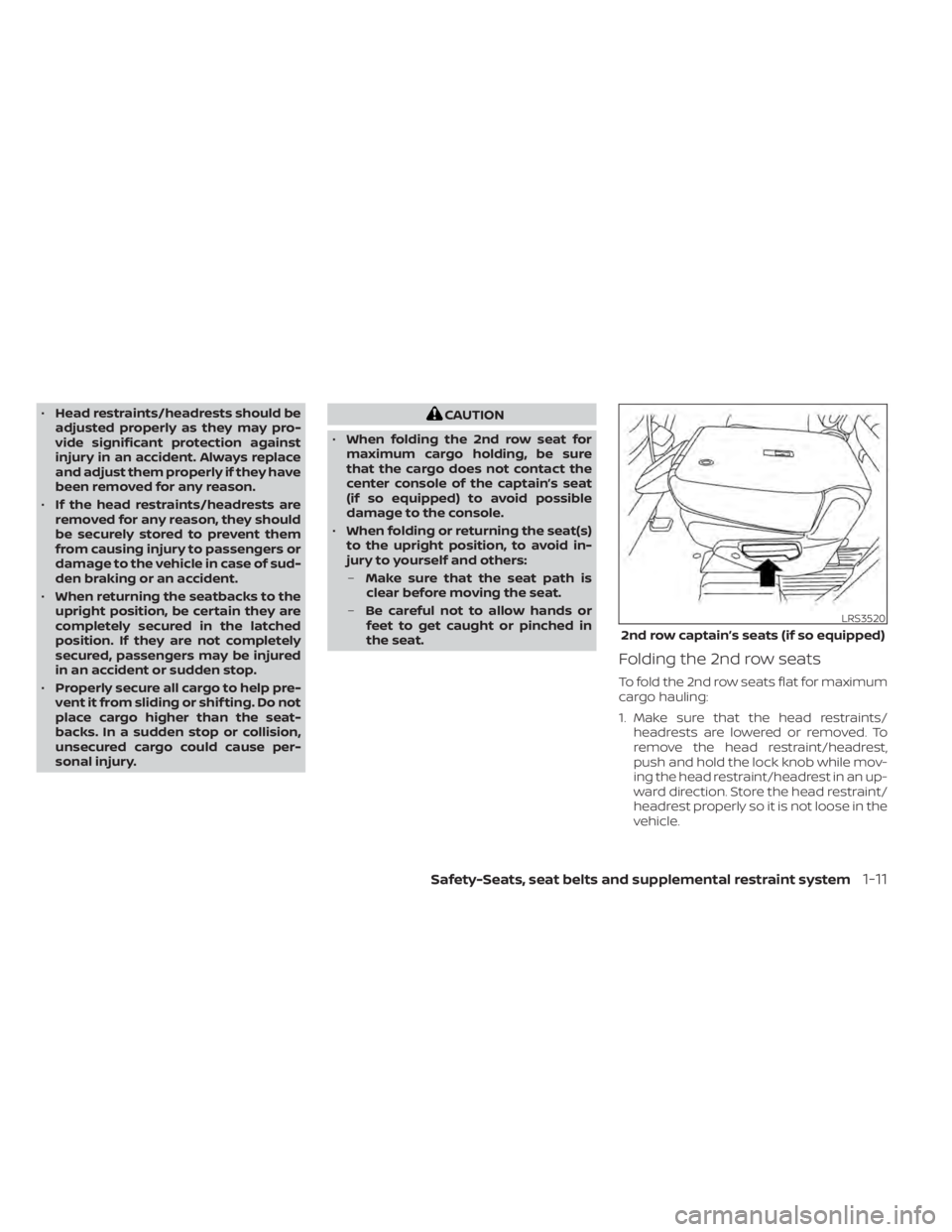
•Head restraints/headrests should be
adjusted properly as they may pro-
vide significant protection against
injury in an accident. Always replace
and adjust them properly if they have
been removed for any reason.
• If the head restraints/headrests are
removed for any reason, they should
be securely stored to prevent them
from causing injury to passengers or
damage to the vehicle in case of sud-
den braking or an accident.
• When returning the seatbacks to the
upright position, be certain they are
completely secured in the latched
position. If they are not completely
secured, passengers may be injured
in an accident or sudden stop.
• Properly secure all cargo to help pre-
vent it from sliding or shif ting. Do not
place cargo higher than the seat-
backs. In a sudden stop or collision,
unsecured cargo could cause per-
sonal injury.CAUTION
• When folding the 2nd row seat for
maximum cargo holding, be sure
that the cargo does not contact the
center console of the captain’s seat
(if so equipped) to avoid possible
damage to the console.
• When folding or returning the seat(s)
to the upright position, to avoid in-
jury to yourself and others:
– Make sure that the seat path is
clear before moving the seat.
– Be careful not to allow hands or
feet to get caught or pinched in
the seat.
Folding the 2nd row seats
To fold the 2nd row seats flat for maximum
cargo hauling:
1. Make sure that the head restraints/ headrests are lowered or removed. To
remove the head restraint/headrest,
push and hold the lock knob while mov-
ing the head restraint/headrest in an up-
ward direction. Store the head restraint/
headrest properly so it is not loose in the
vehicle.
LRS3520
2nd row captain’s seats (if so equipped)
Safety-Seats, seat belts and supplemental restraint system1-11
Page 37 of 665
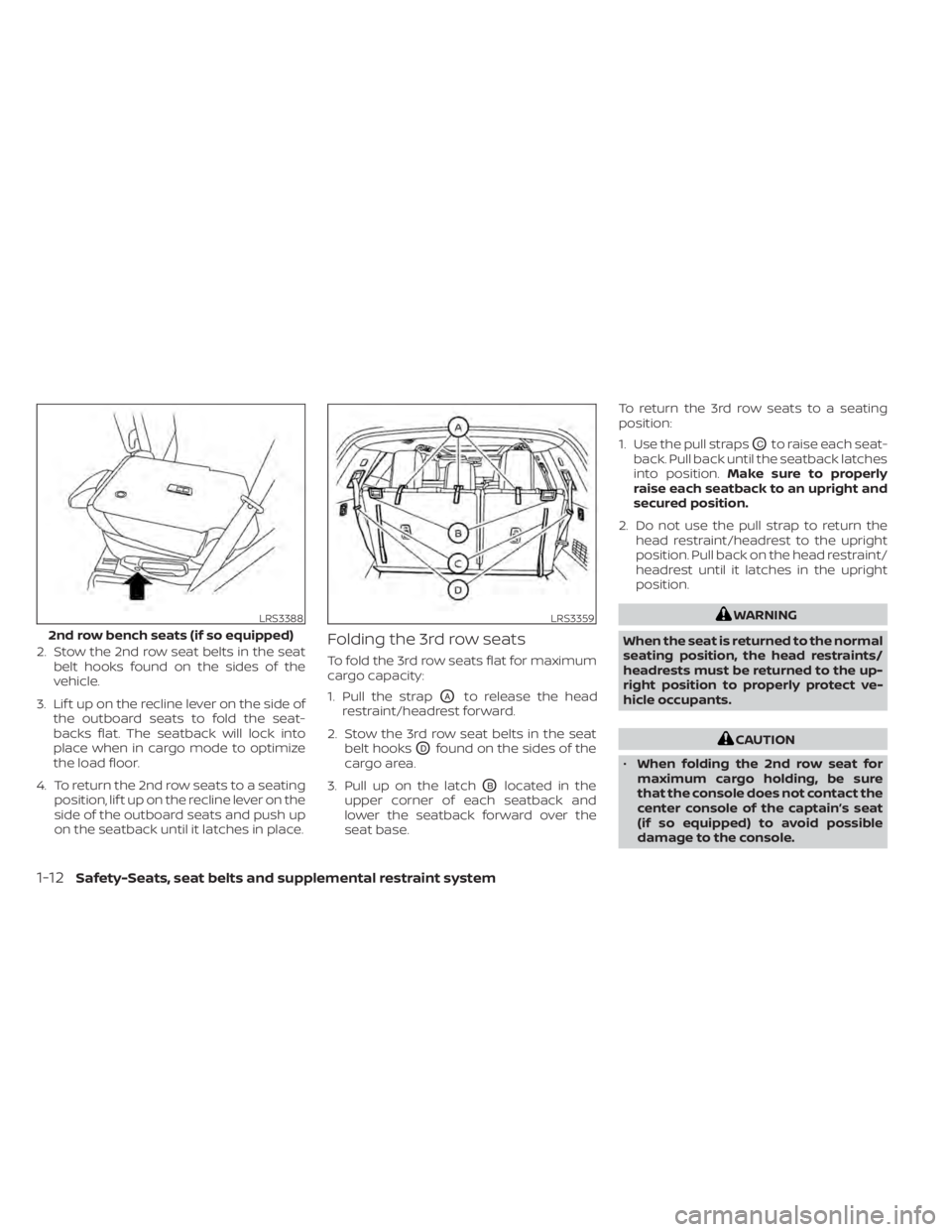
2. Stow the 2nd row seat belts in the seatbelt hooks found on the sides of the
vehicle.
3. Lif t up on the recline lever on the side of the outboard seats to fold the seat-
backs flat. The seatback will lock into
place when in cargo mode to optimize
the load floor.
4. To return the 2nd row seats to a seating position, lif t up on the recline lever on the
side of the outboard seats and push up
on the seatback until it latches in place.Folding the 3rd row seats
To fold the 3rd row seats flat for maximum
cargo capacity:
1. Pull the strap
OAto release the head
restraint/headrest forward.
2. Stow the 3rd row seat belts in the seat belt hooks
ODfound on the sides of the
cargo area.
3. Pull up on the latch
OBlocated in the
upper corner of each seatback and
lower the seatback forward over the
seat base. To return the 3rd row seats to a seating
position:
1. Use the pull straps
OCto raise each seat-
back. Pull back until the seatback latches
into position. Make sure to properly
raise each seatback to an upright and
secured position.
2. Do not use the pull strap to return the head restraint/headrest to the upright
position. Pull back on the head restraint/
headrest until it latches in the upright
position.
WARNING
When the seat is returned to the normal
seating position, the head restraints/
headrests must be returned to the up-
right position to properly protect ve-
hicle occupants.
CAUTION
• When folding the 2nd row seat for
maximum cargo holding, be sure
that the console does not contact the
center console of the captain’s seat
(if so equipped) to avoid possible
damage to the console.
LRS3388
2nd row bench seats (if so equipped)
LRS3359
1-12Safety-Seats, seat belts and supplemental restraint system
Page 44 of 665
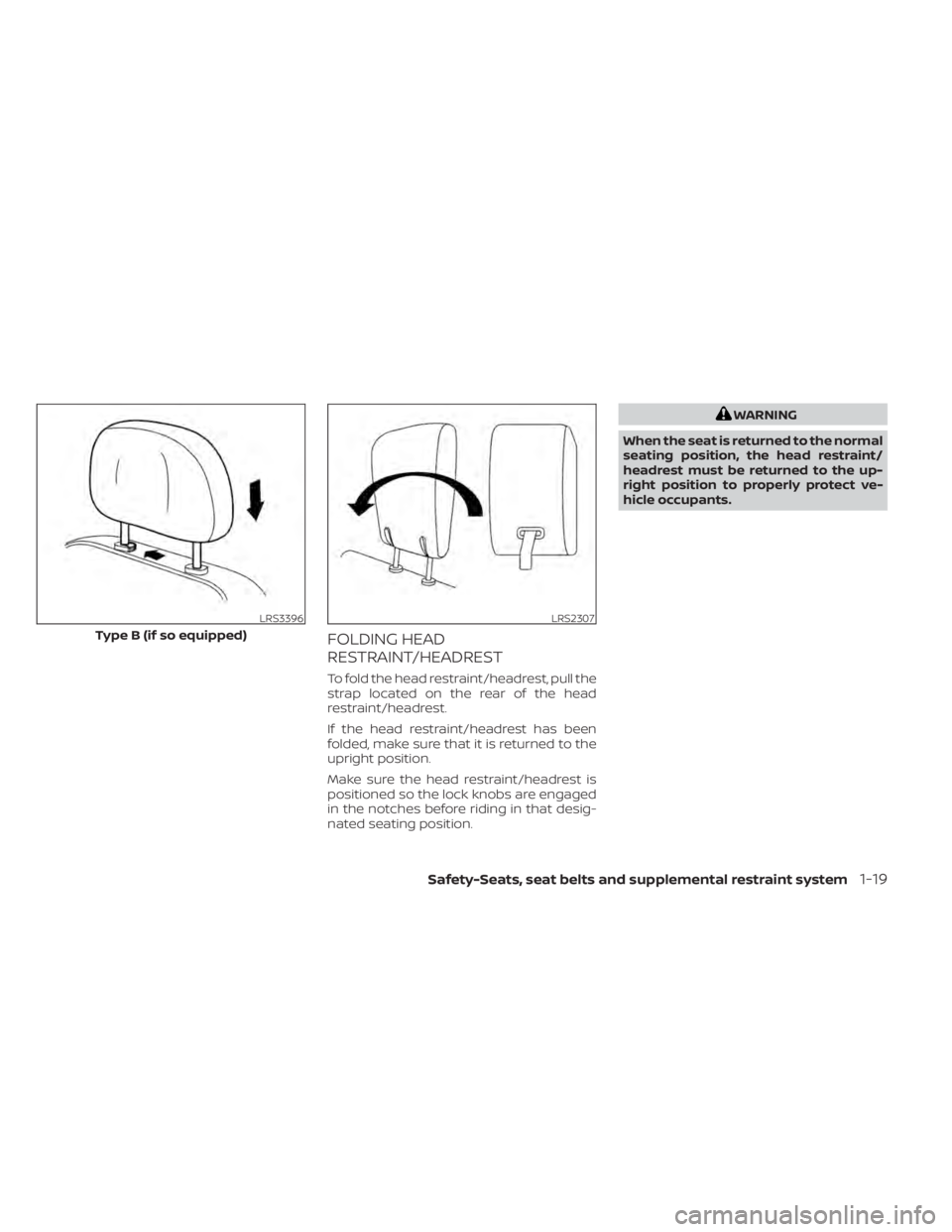
FOLDING HEAD
RESTRAINT/HEADREST
To fold the head restraint/headrest, pull the
strap located on the rear of the head
restraint/headrest.
If the head restraint/headrest has been
folded, make sure that it is returned to the
upright position.
Make sure the head restraint/headrest is
positioned so the lock knobs are engaged
in the notches before riding in that desig-
nated seating position.
WARNING
When the seat is returned to the normal
seating position, the head restraint/
headrest must be returned to the up-
right position to properly protect ve-
hicle occupants.
LRS3396
Type B (if so equipped)
LRS2307
Safety-Seats, seat belts and supplemental restraint system1-19
Page 52 of 665
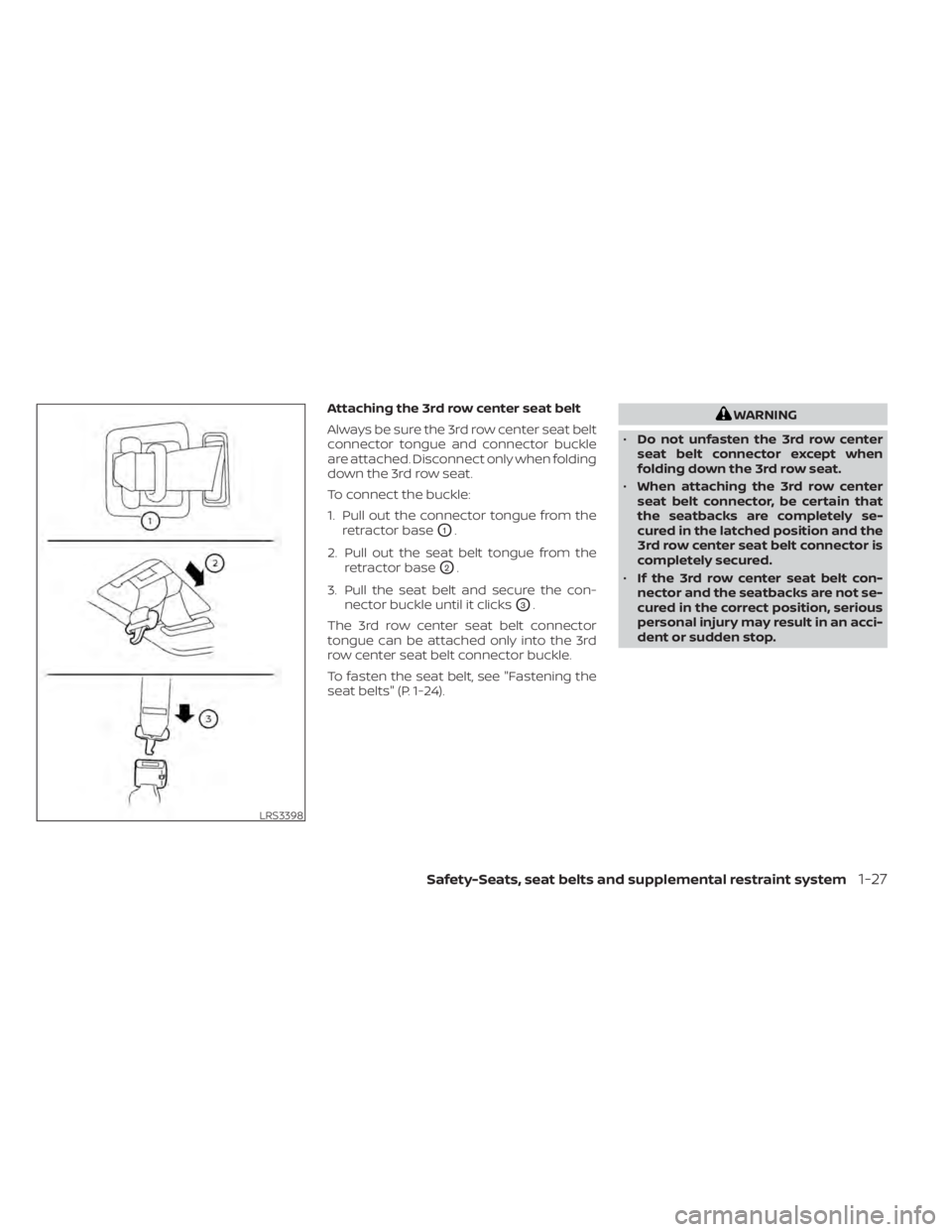
Attaching the 3rd row center seat belt
Always be sure the 3rd row center seat belt
connector tongue and connector buckle
are attached. Disconnect only when folding
down the 3rd row seat.
To connect the buckle:
1. Pull out the connector tongue from theretractor base
O1.
2. Pull out the seat belt tongue from the retractor base
O2.
3. Pull the seat belt and secure the con- nector buckle until it clicks
O3.
The 3rd row center seat belt connector
tongue can be attached only into the 3rd
row center seat belt connector buckle.
To fasten the seat belt, see "Fastening the
seat belts" (P. 1-24).
WARNING
• Do not unfasten the 3rd row center
seat belt connector except when
folding down the 3rd row seat.
• When attaching the 3rd row center
seat belt connector, be certain that
the seatbacks are completely se-
cured in the latched position and the
3rd row center seat belt connector is
completely secured.
• If the 3rd row center seat belt con-
nector and the seatbacks are not se-
cured in the correct position, serious
personal injury may result in an acci-
dent or sudden stop.
LRS3398
Safety-Seats, seat belts and supplemental restraint system1-27